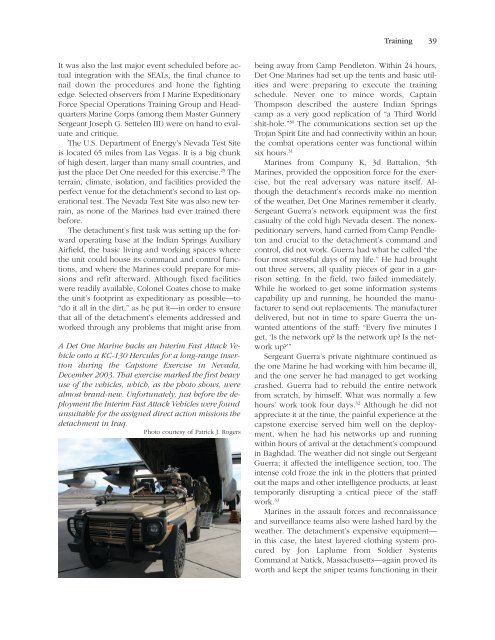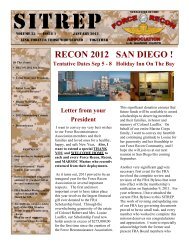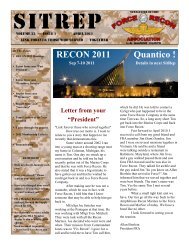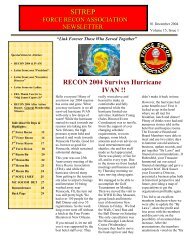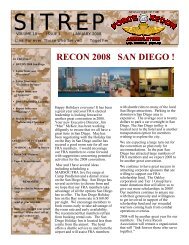Det One - Force Recon Association
Det One - Force Recon Association
Det One - Force Recon Association
You also want an ePaper? Increase the reach of your titles
YUMPU automatically turns print PDFs into web optimized ePapers that Google loves.
Training 39<br />
It was also the last major event scheduled before actual<br />
integration with the SEALs, the final chance to<br />
nail down the procedures and hone the fighting<br />
edge. Selected observers from I Marine Expeditionary<br />
<strong>Force</strong> Special Operations Training Group and Headquarters<br />
Marine Corps (among them Master Gunnery<br />
Sergeant Joseph G. Settelen III) were on hand to evaluate<br />
and critique.<br />
The U.S. Department of Energy’s Nevada Test Site<br />
is located 65 miles from Las Vegas. It is a big chunk<br />
of high desert, larger than many small countries, and<br />
just the place <strong>Det</strong> <strong>One</strong> needed for this exercise. 29 The<br />
terrain, climate, isolation, and facilities provided the<br />
perfect venue for the detachment’s second to last operational<br />
test. The Nevada Test Site was also new terrain,<br />
as none of the Marines had ever trained there<br />
before.<br />
The detachment’s first task was setting up the forward<br />
operating base at the Indian Springs Auxiliary<br />
Airfield, the basic living and working spaces where<br />
the unit could house its command and control functions,<br />
and where the Marines could prepare for missions<br />
and refit afterward. Although fixed facilities<br />
were readily available, Colonel Coates chose to make<br />
the unit’s footprint as expeditionary as possible—to<br />
“do it all in the dirt,” as he put it—in order to ensure<br />
that all of the detachment’s elements addressed and<br />
worked through any problems that might arise from<br />
A <strong>Det</strong> <strong>One</strong> Marine backs an Interim Fast Attack Vehicle<br />
onto a KC-130 Hercules for a long-range insertion<br />
during the Capstone Exercise in Nevada,<br />
December 2003. That exercise marked the first heavy<br />
use of the vehicles, which, as the photo shows, were<br />
almost brand-new. Unfortunately, just before the deployment<br />
the Interim Fast Attack Vehicles were found<br />
unsuitable for the assigned direct action missions the<br />
detachment in Iraq.<br />
Photo courtesy of Patrick J. Rogers<br />
being away from Camp Pendleton. Within 24 hours,<br />
<strong>Det</strong> <strong>One</strong> Marines had set up the tents and basic utilities<br />
and were preparing to execute the training<br />
schedule. Never one to mince words, Captain<br />
Thompson described the austere Indian Springs<br />
camp as a very good replication of “a Third World<br />
shit-hole.” 30 The communications section set up the<br />
Trojan Spirit Lite and had connectivity within an hour;<br />
the combat operations center was functional within<br />
six hours. 31<br />
Marines from Company K, 3d Battalion, 5th<br />
Marines, provided the opposition force for the exercise,<br />
but the real adversary was nature itself. Although<br />
the detachment’s records make no mention<br />
of the weather, <strong>Det</strong> <strong>One</strong> Marines remember it clearly.<br />
Sergeant Guerra’s network equipment was the first<br />
casualty of the cold high Nevada desert. The nonexpeditionary<br />
servers, hand carried from Camp Pendleton<br />
and crucial to the detachment’s command and<br />
control, did not work. Guerra had what he called “the<br />
four most stressful days of my life.” He had brought<br />
out three servers, all quality pieces of gear in a garrison<br />
setting. In the field, two failed immediately.<br />
While he worked to get some information systems<br />
capability up and running, he hounded the manufacturer<br />
to send out replacements. The manufacturer<br />
delivered, but not in time to spare Guerra the unwanted<br />
attentions of the staff: “Every five minutes I<br />
get, ‘Is the network up Is the network up Is the network<br />
up’”<br />
Sergeant Guerra’s private nightmare continued as<br />
the one Marine he had working with him became ill,<br />
and the one server he had managed to get working<br />
crashed. Guerra had to rebuild the entire network<br />
from scratch, by himself. What was normally a few<br />
hours’ work took four days. 32 Although he did not<br />
appreciate it at the time, the painful experience at the<br />
capstone exercise served him well on the deployment,<br />
when he had his networks up and running<br />
within hours of arrival at the detachment’s compound<br />
in Baghdad. The weather did not single out Sergeant<br />
Guerra; it affected the intelligence section, too. The<br />
intense cold froze the ink in the plotters that printed<br />
out the maps and other intelligence products, at least<br />
temporarily disrupting a critical piece of the staff<br />
work. 33<br />
Marines in the assault forces and reconnaissance<br />
and surveillance teams also were lashed hard by the<br />
weather. The detachment’s expensive equipment—<br />
in this case, the latest layered clothing system procured<br />
by Jon Laplume from Soldier Systems<br />
Command at Natick, Massachusetts—again proved its<br />
worth and kept the sniper teams functioning in their


